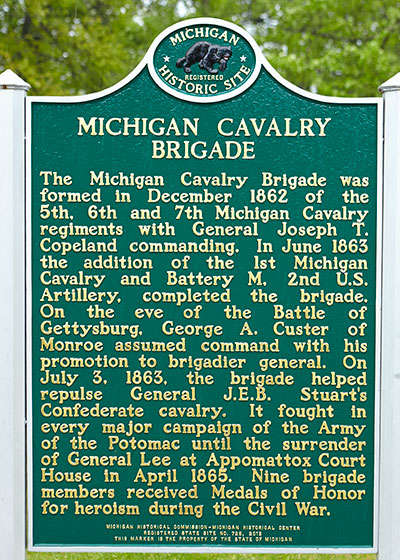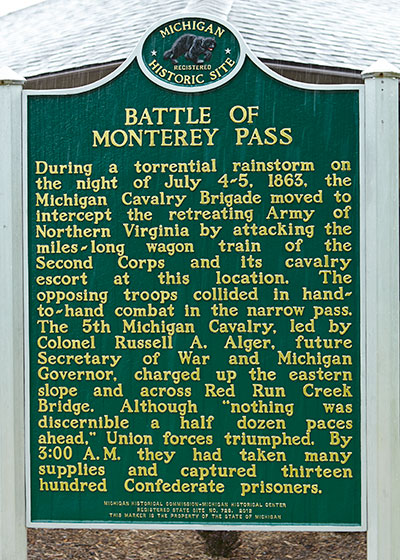Michigan's Historical Marker program was started in 1955 to assist the citizens of the State in identifying their history. The distinguishable green markers spread across Michigan and into other states telling a small story with each. The markers listed below are the ones that are related to the many stories that Michigan has to tell from the Civil War. The year of commission, title of the marker, text, location and a growing list of photographs are provided. This allows you to visit them in person, virtually or both. We have grouped them by geographical region.
If you are looking to visit a certain region, just click below and you will be taken to the part of the page pertaining to your selection.
- Metro Detroit Area, Michigan
- Monroe, Michigan
- Ypsilanti, Michigan
- Brighton/Howell Area, Michigan
- Jackson, Michigan
- Lansing Metro Area, Michigan
- Flint, Michigan
- Byron, Michigan
- Adrian, Michigan
- Marshall, Michigan
- Coldwater, Michigan
- Vandalia, Michigan
- Grand Rapids/Holland Area, Michigan
- Benzonia, Michigan
- Lincoln, Michigan
- Roscommon, Michigan
- Saugatuck, Michigan
- South Mountain Battlefield, Maryland
- Waynesboro, Pennsylvania
- Richmond, Kentucky
- Perryville, Kentucky
Metro Detroit Area
Historic Fort Wayne
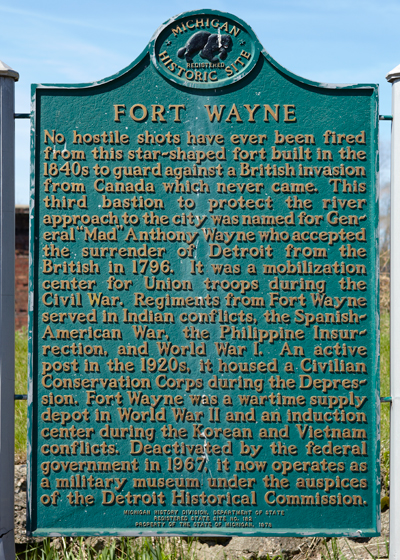
This marker can be found at - 6825 W Jefferson Ave, Detroit MI. It was erected in 1977.
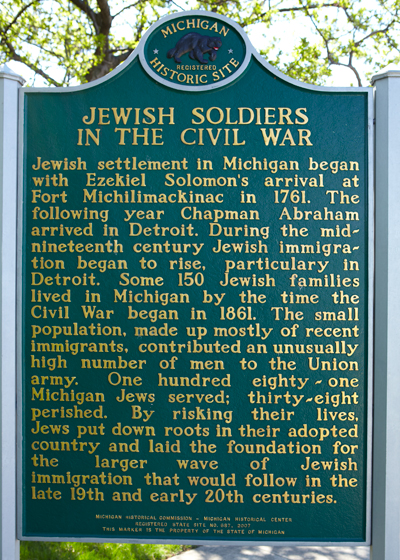
This marker can be found at William G. Milliken State Park, 1900 Atwater St, Detroit MI. It was erected in 2007.
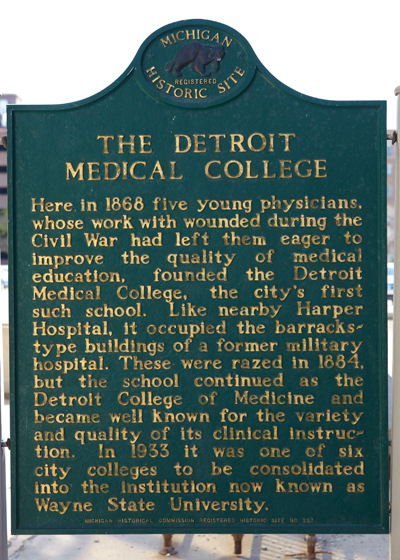
Visit this marker at 3800 Woodward Ave, Detroit MI. It was erected in 1967.
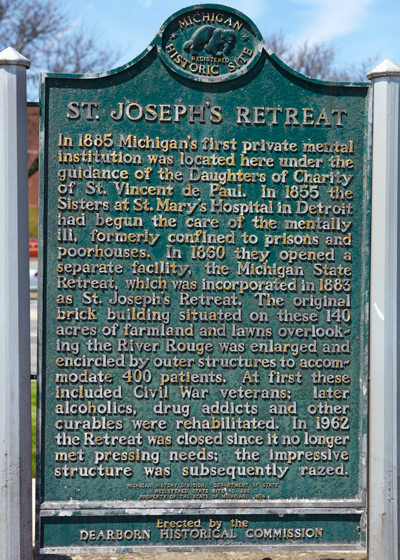
This marker is located at 23300 Michigan Ave, Dearborn MI. It was erected in 1974.
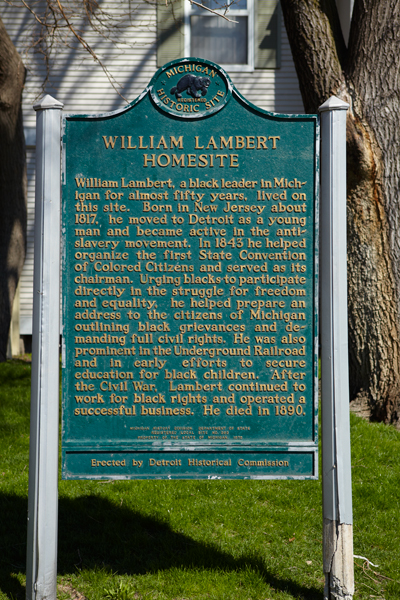
This marker can be viewed on Larned east of St. Aubin, Detroit MI. It was erected in 1975.
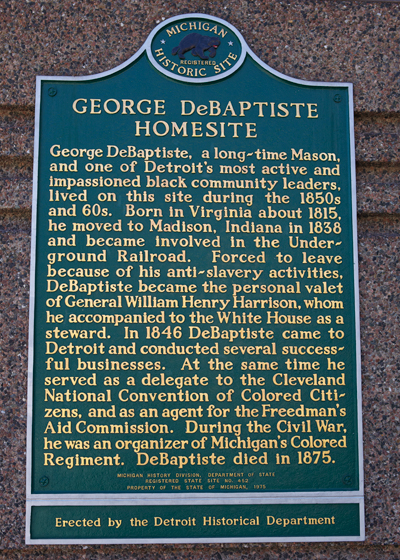
Visit this marker at the SW corner of Larned and Beaubien, Detroit MI. It was erected in 1975.
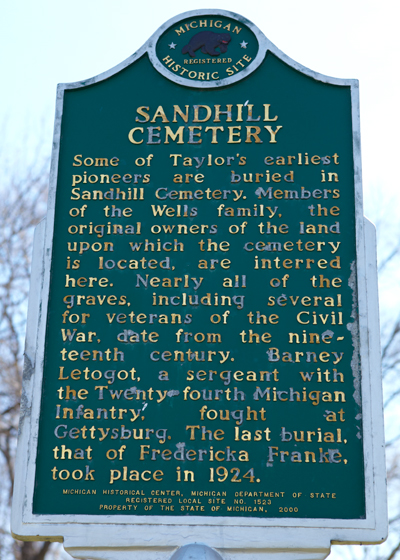
This is the furthest marker we include in the Detroit Metro area from the City's center. View it at Telegraph and Pardee Rd, Just west of Eureka on Telegraph, Taylor MI. It was erected in 2000.
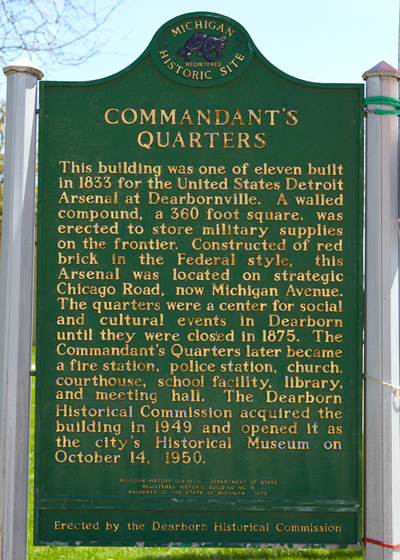
Though it saw little service, the Dearborn Arsenal was open during the Civil War. You can visit this marker in Dearborn and tour the Commandant's Quarters at the same time.
Redford Cemetery
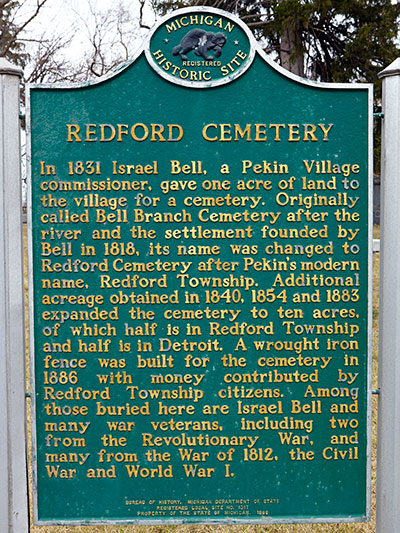
Marker Text: In 1831 Israel Bell, a Pekin Village commissioner, gave one acre of land to the village for a cemetery. Originally called Bell Branch Cemetery after the river and the settlement founded by Bell in 1818, its name was changed to Redford Cemetery after Pekin's modern name, Redford Township. Additional acreage obtained in 1849, 1854 and 1883 expanded the cemetery to ten acres of which half is in Redford Township and half is in Detroit. A wrought iron fence was built for the cemetery in 1886 with money contributed by Redford Township citizens. Among those buried here are Israel Bell and many war veterans, including two from the Revolutionary War, and many from the War of 1812, the Civil War and World War I.
This marker is located on Main Street south of 12 Mile Road in Royal Oak, MI. It was erected in 1988.
Pine Grove
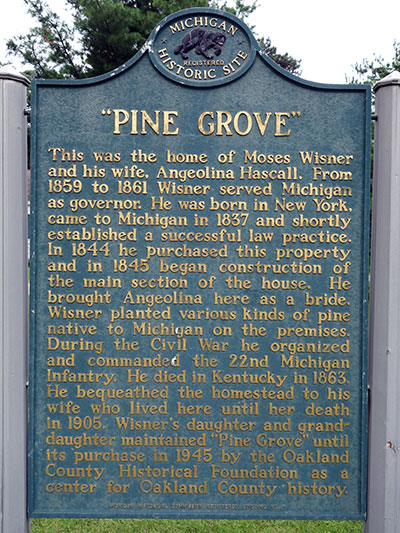
Marker Text: This was the home of Moses Wisner and his wife Angeolina Hascall. From 1859 to 1861, Wisner served Michigan as governor. He was born in New York, came to Michigan in 1837 and shortly established a successful law practice. In 1844 he purchased this property and in 1845 began construction of the main section of the house. He brought Angeolina here as a bride. Wisner planted various kinds of pine native to Michigan on the premises. During the Civil War he organized and commanded the 22nd Michigan Infantry. He died in Kentucky in 1863. He bequeathed his homestead to his wife who lived here until her death in 1905. Wisner's daughter and grand-daughter maintained "Pine Grove" until its purchase by the Oakland County Historical Foundation as a center for Oakland County history.
The marker is located at 405 Oakland Ave. in Pontiac. It was erected in 1961.
Oak Hill Cemetery
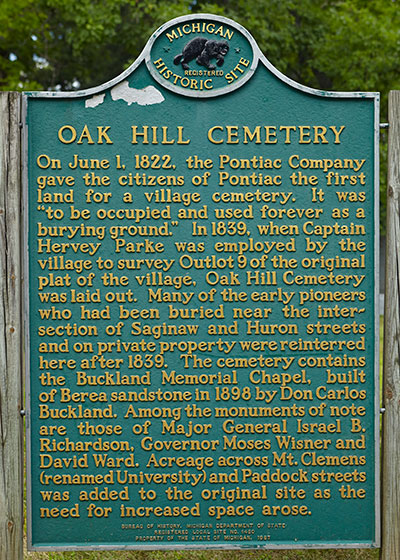
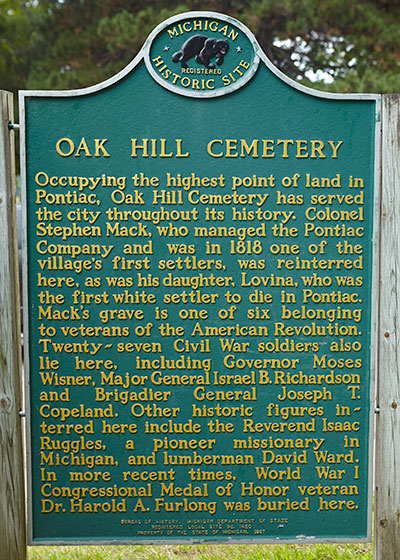
Marker Text: On June 1, 1822, the Pontiac Company gave the citizens of Pontiac the first land for a village cemetery. it was "to be occupied and used forever as a burying ground." In 1939, when Captain Hervey Parke was employed by the village to survey Outlot 9 of the original plat of the village, Oak Hill Cemetery was laid out. Many of the early pioneers who had been buried near the intersection of Saginaw and Huron streets and on private property were reinterred here after 1839. The cemetery contains the Buckland Memorial Chapel, built of Berea sandstone in 1898 by Don Carlos Buckland. Amoung the monuments of note are those of Major General Israel B. Richardson, Governor Moses Wisner and David Ward. Acreage across Mt. Clemens (renamed University) and Paddock streets was added to the original site as the need for increased as the need for increased space arose. Occupying the highest point of land in Pontiac, Oak Hill Cemetery has served the city throughout its history. Colonel Stephen Mack, who managed the Pontiac Company and was in 1818 one of the village's first settlers, was reinterred here, as was his daughter, Lovina, who was the first white settler to die in Pontiac. Mack's grave is one of six belonging to veterans of the American Revolution. Twenty-seven Civil War soldiers also lie here, including Governor Moses Wisner, Major General Israel B. Richardson and Brigadier General Joseph T. Copeland. Other historic figures interred here include the Reverend Isaac Ruggles, a pioneer missionary in Michigan, and lumberman David Ward. In more recent times, World War I Congressional Medal of Honor veteran Dr. Harold A. Furlong was buried here.
This marker is located at 216 University Dr, Pontiac MI. It was erected in 1987.
Joseph Tarr Copeland
Marker Text: Maine native Joseph Tarr Copeland (1813 - 1893) graduated from Harvard College and studied law before coming to Michigan during the 1840s. In 1851 he was elected circuit court judge serving concurrently on the Michigan Supreme Court. Upon his retirement in 1858, he built this house. At the outbreak of the Civil War in 1861 he was commissioned a lieutenant colonel in the First Michigan Calvary. Within a year he rose to brigadier general. Copeland retired to his home in 1865. With a group of Pontiac investors Copeland enlarged his house, creating the Orchard Lake Hotel. From this site tourists boarded the Pride of the Lake and traveled to Apple Island. The panic of 1873 ruined the venture. Copeland sold the property in 1877 to Colonel Joseph Summer Rodgers who established the Michigan Military Academy on this site.
This marker is located in Orchard Lake, Michigan. It was erected in 1995.
Mount Avon Cemetery
Marker Text: In 1826, Mount Avon became the first officially platted cemetery in Oakland County. The "Old Ground" or "Historic Acre" contains headstones dating from 1817, the year the earliest settlers arrived in the area. Members of the Graham family, Rochester's founders, are buried in Mount Avon, including James Graham (1818-1839), thought to be the first white child born in the county. In 1911 a statue of Billy Yank was erected in memory of Oakland County's Civil War Veterans.
This marker is located at 36000 Ann Arbor Tr, Livonia MI. It was erected in 1993.
White Lake Cemetery
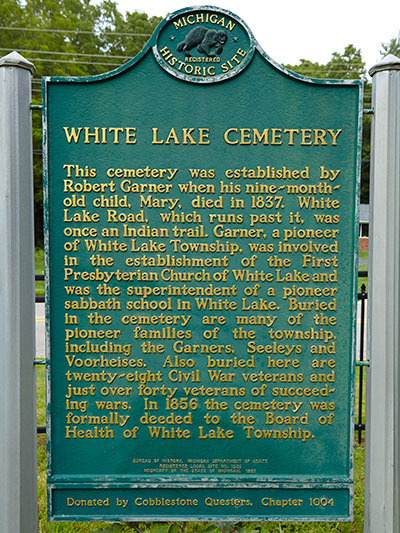
Marker Text: This cemetery was established by Robert Garner when his nine-month-old child, Mary, died in 1837. White Lake Road, which runs past it, was once an Indian trail. Garner, a pioneer of White Lake Township, was involved in the establishment of the First Presbyterian Church of White Lake and was the superintendent of a pioneer sabbath school in White Lake. Buried in the cemetery are many of the pioneer families of the township, including the Garners, Seeleys and Voorheises. Also buried here are twenty-eight Civil War veterans and just over forty veterans of succeeding wars. In 1856 the cemetery was formally deeded to the Board of Health of White Lake Township.
This marker is located at 6190 White Lake Rd, White Lake Twp MI. It was erected in 1987.
Predmore House
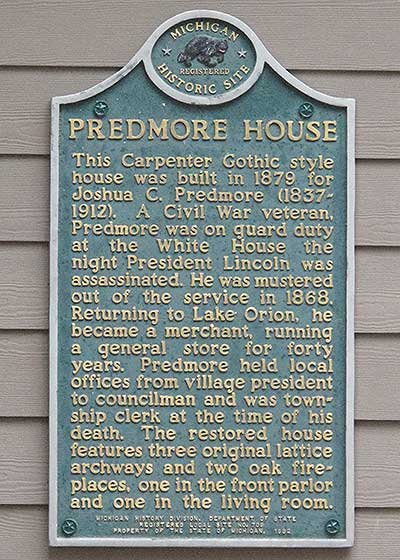
Marker Text: This Carpenter Gothic style house was built in 1879 for Joshua C. Predmore (1837-1912). A Civil War veteran, Predmore was on guard duty at the White House the night President Lincoln was assassinated. He was mustered out of the service in 1868. Returning to Lake Orion, he became a merchant, running a general store for forty years. Predmore held local offices from village president to councilman and was township clerk at the time of his death. The restored house features three original lattice archways and two oak fireplaces, one in the front parlor and one in the living room.
This marker is locate at 244 N Broadway, Lake Orion MI. It was erected in 1982.
Colonel Brodhead's Office
Marker Text: Colonel Thornton Fleming Brodhead (1822-1862) and his wife, Archange Macomb Abbott, lived on the hill just north of this site. This small stone office and library building was constructed around 1855. Colonel Brodhead was, at various times, editor and part owner of the Detroit Free Press, state senator and postmaster at Detroit. He served in the Mexican War and led the First Michigan Cavalry in the Civil War. The colonel was mortally wounded at the Second Battle of Bull Run.
This marker is located at 20604 East River Rd, Grosse Ile, MI. It was erected in 1980.
Detroit Free Press
Marker Text: The Detroit Free Press began publishing as the Democratic Free Press and Michigan Intelligencer on the morning of May 5, 1831. Michigan's oldest daily newspaper, it supported the drive for statehood, helped establish the Associated Press and sent reporters to the battlefield to cover the Civil War. In 1853 the Free Press began publishing the state's first Sunday newspaper. By its 150th year its staff had earned six Pulitzer Prizes. The Lafayette Boulevard building, built in 1925, was designed by Albert Kahn.
Reported to be located at 600 Fort Street in Detroit, MI, this marker could not be located.
St Matthew's Episcopal Church
Marker Text: Founded in 1846, St. Matthew's Church has served prominent and well established members of Detroit's black community. The combined influence of businessman William Lambert and William Monroe, first pastor of Second Baptist Church, drew members to the new congregation. St. Matthew's was forced to close during the Civil War due to declining membership. Many members had fled to Canada to escape the effects of the 1850 Fugitive Slave Act. The Reverend Monroe resigned and emigrated to Liberia. In 1881 the church reopened, becoming the center for reform groups and self-improvement clubs. Among St. Matthew's well-known ministers were former professor Charles Thompson and Robert Bagnall, organizer of Detroit's chapter of the National Association for the Advancement of Colored People.
The location this marker was located to be at is extremely close to where Ford Field is currently located. It was not able to be found and is suspected to be removed or relocated. The church building also no longer exists. It was erected in 1976.
Royal Oak Township Cemetery
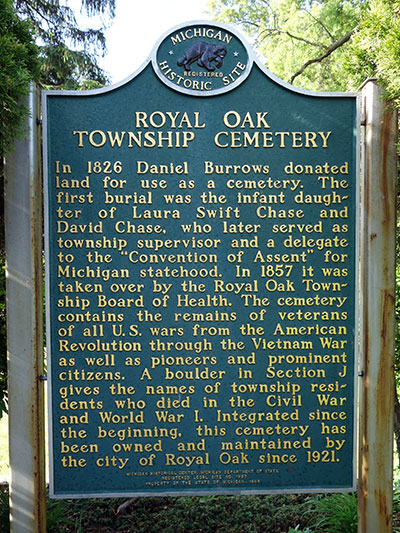
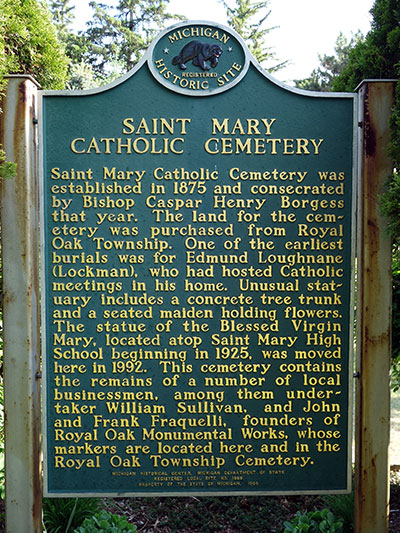
Monroe, Michigan
George Armstrong Custer
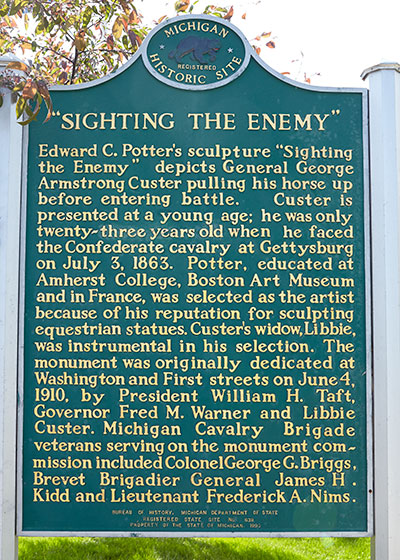
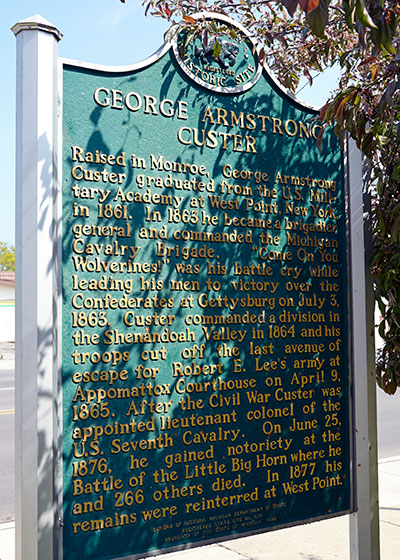
Marker Text: Raised in Monroe, George Armstrong Custer graduated from the U.S. Military Academy at West Point, New York in 1861. In 1863 he became a brigadier general and commanded the Michigan Cavalry Brigade. "Come On You Wolverine's!" was his battle cry while leading his men to victory over the Confederates at Gettysburg on July 3, 1863. Custer commanded a division in the Shenandoah Valley in 1864 and his troops cut off the last avenue of escape for Robert E. Lee's army at Appomattox Courthouse on April 19, 1865. After the Civil War Custer was appointed lieutenant colonel of the U.S. Seventh Cavalry. On June 25, 1876, he gained notoriety at the Battle of the Little Big Horn where he and 266 others died. In 1877 his remains were reinterred at West Point.
This marker is located near the intersection of N Monroe St at Elm, Monroe MI. It was erected in 1993.
Ypsilanti, Michigan
The Barracks
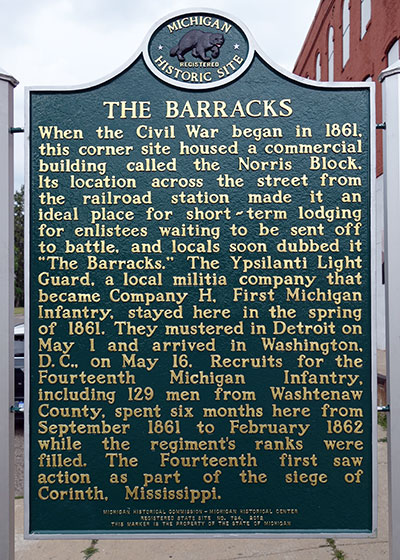
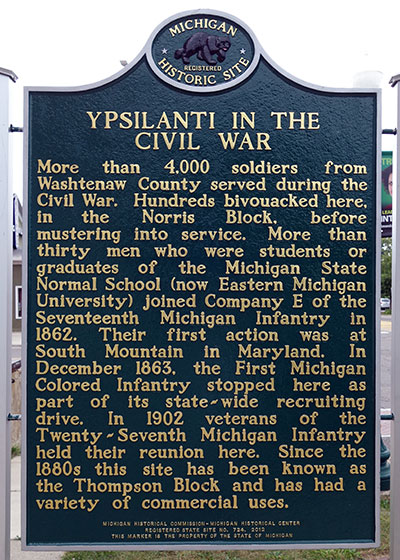
Marker Text: When the Civil War began in 1861, this corner site housed a commercial building called the Norris Block. Its location across the street from the railroad station made it an ideal place for short-term lodging for enlistees waiting to be sent off to battle, and locals soon dubbed it The Barracks. The Ypsilanti Light Guard, a local militia company that became Company H, First Michigan Infantry, stayed here in the spring of 1861. They mustered in Detroit on May 1 and arrived in Washington, D.C., on May 16. Recruits for the Fourteenth Michigan Infantry, including 129 men from Washtenaw County, spent six months here from September 1861 to February 1862 while the regiments ranks were filled. The Fourteenth first saw action as part of the siege of Corinth, Mississippi. When the Civil War began in 1861, this corner site housed a commercial building called the Norris Block. Its location across the street from the railroad station made it an ideal place for short-term lodging for enlistees waiting to be sent off to battle, and locals soon dubbed it The Barracks. The Ypsilanti Light Guard, a local militia company that became Company H, First Michigan Infantry, stayed here in the spring of 1861. They mustered in Detroit on May 1 and arrived in Washington, D.C., on May 16. Recruits for the Fourteenth Michigan Infantry, including 129 men from Washtenaw County, spent six months here from September 1861 to February 1862 while the regiments ranks were filled. The Fourteenth first saw action as part of the siege of Corinth, Mississippi.
This marker is located at 404 N River St, Ypsilanti MI. It was erected in 2012.
Brighton/Howell Area
George W. Lee House
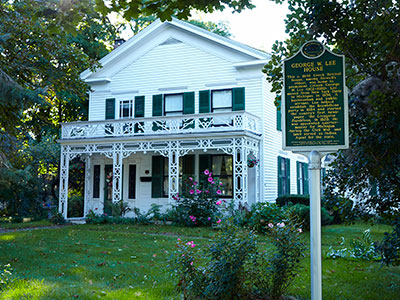
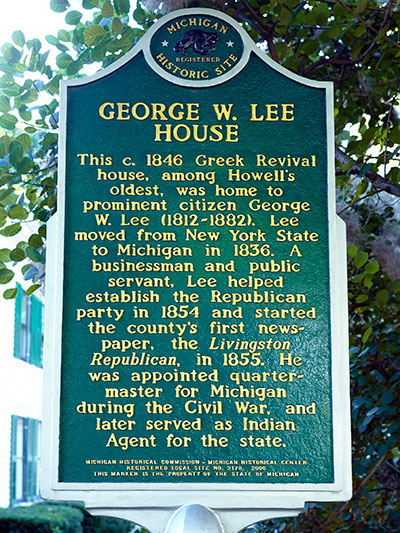
Marker Text: This c. 1846 Greek Revival house, among Howell's oldest, was the home to prominent citizen George W. Lee (1812-1882). Lee moved from New York State to Michigan in 1836. A bussinessman and public servant, Lee helped establish the Republican Party in 1854 and started the county's first newspaper, the Livingston Republican, in 1855. We was appointed quartermaster for Michigan during the Civil War,and later served as Indian Agent for the State.
This marker is located at 404 S. Walnut St, Howell MI. It was erected in 2007. The house appears to be a private residence. The sign can easily be viewed from the street or sidewalk so there should be no reason to intrude on private property.
Livingston County Press
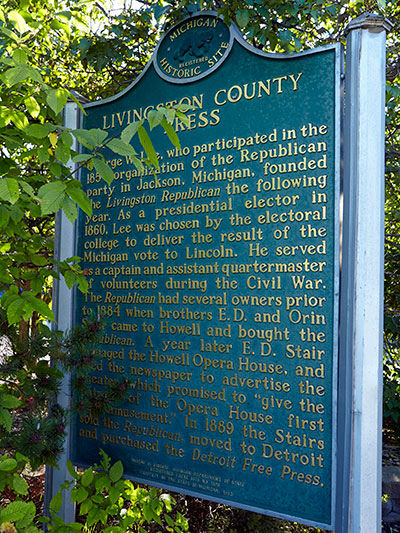
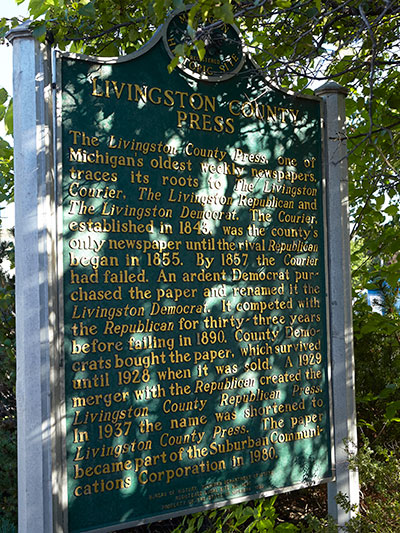
Marker Text: The Livingston County Press, one of Michigan's oldest weekly newspapers, traces its roots to The Livingston Courier, The Livingston Republican and The Livingston Democrat. The Courier, established in 1843 was the county's only newspaper until the rival Republican began in 1855. By 1857 the Courier had failed. An ardent Democrat purchased the paper and renamed it the Livingston Democrat. It competed with the Republican for thirty-three years before failing in 1890. County Democrats bought the paper which survived until 1928 when it was sold. A 1929 merger with the Republican created the Livingston County Republican Press. In 1937 the name was shortened to the Livingston County Press. The Paper became part of the Suburban Communications Corporation in 1980. George W. Lee, who participated in the 1854 organization of the Republican party in Jackson, Michigan, founded the Livingston Republican the following year. As a presidential elector in 1860, Lee was chosen by the electoral college to deliver the result of the Michigan vote to Lincoln. He served as a captain and assistant quartermaster of volunteers during the Civil War. The Republican had several owners prior to 1884 when brothers E.D. and Orin Stair came to Howell and bought the Republican. A year later E.D. Stair managed the Howell Opera House, and used the newspaper to advertise the theater, which promised to "give the patrons of the Opera House first class amusement." In 1889 the Stairs sold the Republican, moved to Detroit and purchased the Detroit Free Press.
This marker is located at 323 E Grand River, Howell MI. It was erected in 1993.
Hartland Burying Ground
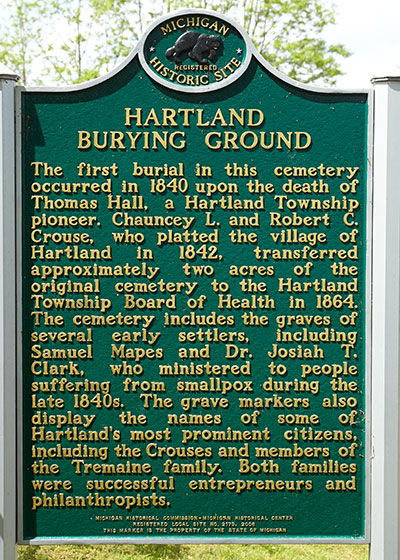
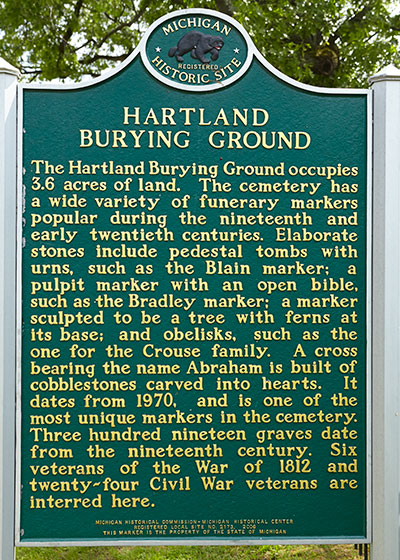
Marker Text: The Hartland Burying Ground occupies 3.6 acres of land. The cemetery has a wide variety of funerary markers popular during the nineteenth and early twentieth centuries. Elaborate stones include pedestal tombs with urns, such as the Blain marker; a pulpit marker with an open bible, such as the Bradley marker; a marker sculpted to be a tree with ferns at its base; and obelisks, such as the one for the Crouse family. A cross bearing the name Abraham is built of cobblestones carved into hearts. It dates from 1970, and is one of the most unique markers in the cemetery. Three hundred nineteen graves date from the nineteenth century. Six veterans of the war of 1812 and twenty-four Civil War veterans are interred here. The first burial in this cemetery occurred in 1840 upon the death of Thomas Hall, a Hartland Township pioneer. Chauncey L. and Robert C. Crouse, who platted the village of Hartland in 1842, transferred approximately two acres of the original cemetery to the Hartland Township Board of Health in 1864. The cemetery includes the graves of several early settlers, including Samuel Mapes and Dr. Josiah T. Clark, who ministered to people suffering from smallpox during the late 1840s. The grave markers also display the names of some of Hartland's most prominent citizens, including the Crouses and members of the Tremaine family. Both families were successful entrepreneurs and philanthropists.
This marker is located at 1312 Avon St, Hartland MI. It was erected in 2006.
Oak Grove Cemetery
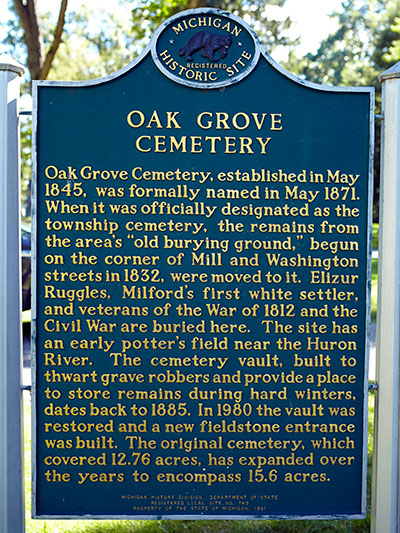
Marker Text: Oak Grove Cemetery, established in May 1845, was formally named in May 1871. When it was officially designated as the township cemetery, the remains from the area's "old burying ground." begun on the corner of Mill and Washington streets in 1832, were moved to it. Elizur Ruggles, Milford's first white settler, and veterans of the War of 1812 and the Civil War are buried here. The site has an early potter's field near the Huron River. The cemetery vault, built to thwart grave robbers and provide a place to store remains during hard winters, dates back to 1885. In 1980 the vault was restored and a new fieldstone entrance was built. The original cemetery, which covered 12.76 acres, has over the years expanded to encompass 15.6 acres.
This marker is located at 1055 Garden St, Milford MI. It was erected in 1981. In addition to this marker, there is a monument erected by GAR post 181 nearby. This is a beautiful place to visit along a river.
West Highland Cemetery
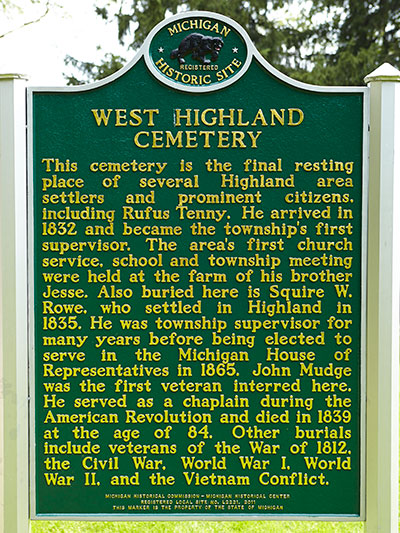
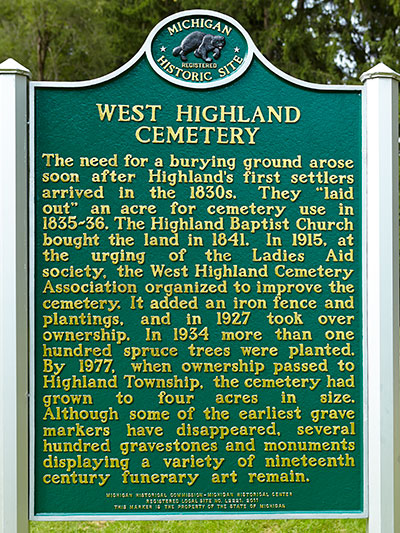
Marker Text: The need for a burying ground arose soon after Highlands first settlers arrived in the 1830s. They laid out an acre for cemetery use in 1935~36. The Highland Baptist Church bought the land in 1841. In 1915, at the urging of the Ladies Aid society, the West Highland Cemetery Association organized to improve the cemetery. It added an iron fence and plantings, and in 1927 took over ownership. In 1934 more than one hundred spruce trees were planted. By 1977, when ownership passed to Highland Township, the cemetery had grown to four acres in size. Although some of the earliest grave markers have disappeared, several hundred gravestones and monuments displaying a variety of nineteenth century funerary art remains. This cemetery is the final resting place of several Highland area settlers and prominent citizens, including Rufus Tenny. He arrived in 1832 and became the township's first supervisor. The area's first church service, school and township meeting were held at the farm of his brother Jesse. Also buried here is Squire W. Rowe, who settled in Highland in 1835. He was township supervisor for many years before being elected to serve in the Michigan House of Representatives in 1865, John Mudge was the first veteran interred here. He served as chaplain during the American Revolution and died in 1839 at the age of 84. Other burials include veterans of the War of 1812m the Civil War, World War I, World War II, and the Vietnam Conflict.
This marker is located at 1136 S. Hickory Ridge Dr, Highland Twp MI. It was erected in 2011.
Jackson, Michigan
Camp Blair
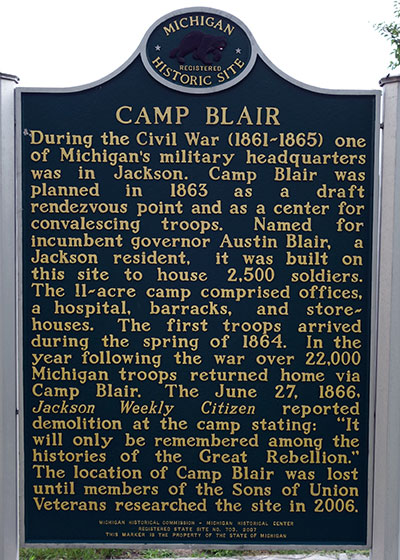
Marker Text: During the the American Civil War (1861-1865) one of Michigan's military headquarters was In Jackson. Camp Blair was planned 1863 as a draft rendezvous point and as a center for convalescing troops. Named for incumbent governor Austin Blair, a Jackson resident, it was built on this site to house 2,500 soilders. The 11-acre camp comprised offices, a hospital, barracks, and store-houses. The first troops arrived during the spring of 1864. In the year following the war over 22,000 Michigan troops returned home via Camp Blair. The June 27, 1866, Jackson Weekly Citizen reported demolition of the camp started: "It will only be remembered among the histories of the Great Rebellion." The location of Camp Blair was lost until members of Sons of Union Veterans researched the site in 2006.
This maker is located at 1212 Wildwood, Jackson MI. It was erected in 2007.
First Congregational Church
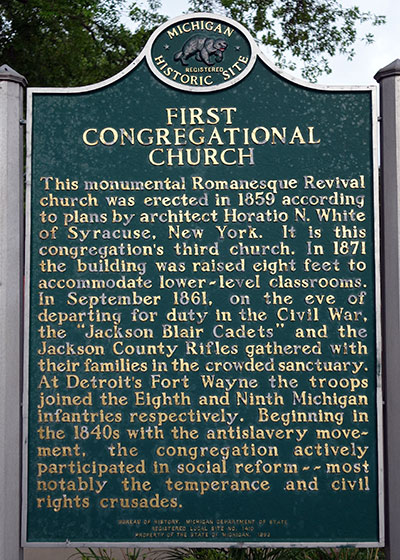
Marker Text: This monumental Romanesque Revival church was erected in 1859 according to plans by architect Horatio N. White of Syracuse, New York. It is this congregation's third church. In 1871 the building was raised eight feet to accommodate lower-level classrooms. In September 1861, on the eve of departing for duty in the Civil War, the "Jackson Blair Cadets" and the Jackson County Rifles gathered with their families in the crowded sanctuary. At Detroit's Fort Wayne the troops joined the Eighth and Ninth Michigan infantries respectively. Beginning in the 1840s with the antislavery movement, the congregation actively participated in social reform -- most notably the temperance and civil rights crusades.
This marker is located at 120 N Jackson, Jackson MI. It was erected in 1993.
Lansing Metro Area
Austin Blair
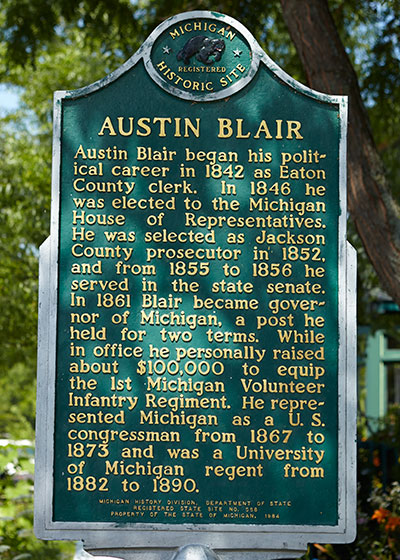
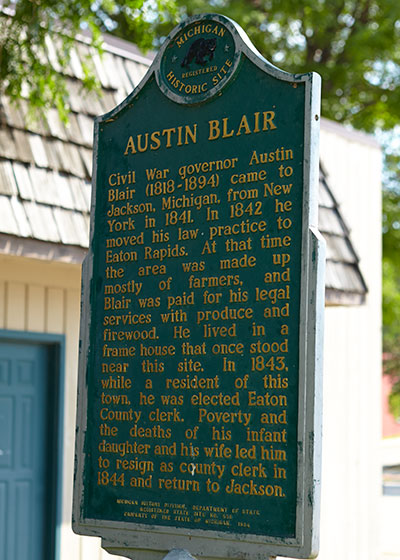
Marker Text: Civil War governor Austin Blair (1818-1894) came to Jackson, Michigan, from New York in 1841. In 1842 he moved his law practice to Eaton Rapids. At that time the area was made up mostly of farmers, and Blair was paid for his services with produce and firewood. He lived in a frame house that once stood near this site. In 1843, while a resident of this town, he was elected Eaton County clerk. Poverty and the deaths of his infant daughter and his wife led him to resign as county clerk and return to Jackson. Austin Blair began his political career in 1842 as Eaton County clerk. In 1846 he was elected to the Michigan House of Representatives. He was selected as Jackson County prosecutor in 1852 and from 1855 to 1856 he served in the state senate. In 1861 Blair became governor of Michigan, a post he held for two terms. While in office he personally raised about $100,000 to equip the 1st Michigan Volunteer Infantry Regiment. He represented Michigan as a U.S. congressman form 1867 to 1873 and was a University of Michigan regent from 1882 to 1890.
This marker is located at 248 S. Main St, Eaton Rapids MI. It was erected in 1984.
GAR Hall
Marker Text: The Samuel W. Grinnell Post No. 283 was granted its charter by the Grand Army of the Republic (G. A. R.) on October 6, 1884. The post operated until 1934, at which time it was disbanded. Members built this hall in 1898-99. Dedicated in October 1899, it contains flags, medals, photographs and other momentos of the Civil War and of the Sunfield veterans of that war. Furniture, ritual equipment and records of this G. A. R. post are also kept here. In 1899 members planted and dedicated three maple trees at the front of the property, dedicating them to the memory of Generals Grant, Sheridan and Sherman. The two cannon on either side of the hall were brought to Sunfield by the G. A. R. in 1900.
The G. A. R. was founded in 1866 as a veterans association to assist Union veterans and their widows and orphans. The G. A. R. and several of its allied orders have used this hall since its completion in 1899; Samuel W. Grinnell Post No. 283, G. A. R. (1899 to 1934); Woman's Relief Corps No. 62 (1899 to 1925); Samuel W. Grinnell Camp No. 17, Sons of Union Veterans, U. S. A., (1918 to 1925); Helen Edwins Tent No. 30, Daughters of Union Veterans of the Civil War (beginning in 1926); and Curtenius Guard Camp No. 17, Sons of Union Veterans of the Civil War (beginning in 1983). In 1987 the hall was owned by the Daughters of Union Veterans of the Civil War. This markers was dedicated on Memorial Day (30 May) during the Michigan Sesquicentennial.
This marker is located at 115 Main St, Sunfield MI. It was erected in 1987.
Mount Hope Cemetery
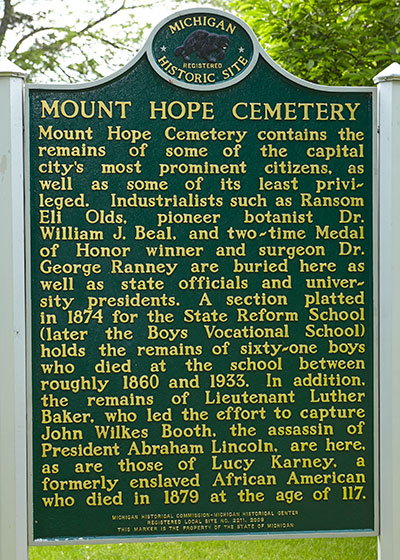
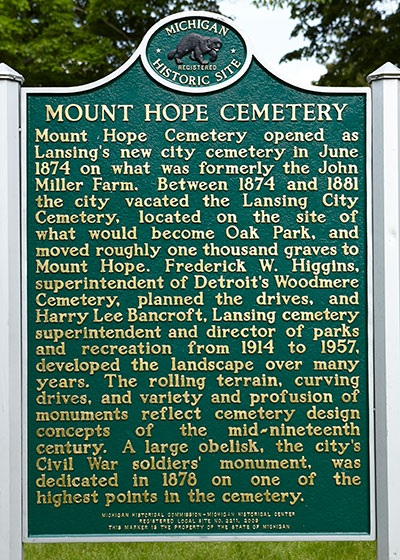
Marker Text: Mount Hope Cemetery opened as Lansing's new city cemetery in June 1874 on what was formerly the John Miller Farm. Between 1874 and 1881 the city vacated the Lansing City Cemetery, located on the site of what would become Oak Park, and moved roughly one thousand graves to Mount Hope. Frederick W. Higgins, superintendent of Detroit's Woodmere Cemetery, planned the drives, and Henry Lee Bancroft, Lansing cemetery superintendent and director of parks and recreation from 1914 to 1957, developed the landscape over many years. The rolling terrain, curving drives, and variety and profusion of monuments reflect cemetery concepts of the mid-nineteenth century. A large obelisk, the city's Civil War soldier's monument was dedicated in 1878 on one of the highest points in the cemetery.
This marker is located at 1709 E Mount Hope Ave, Lansing MI. It was erected in 2009.
Flint, Michigan
Stockton House/Thomas Stockton
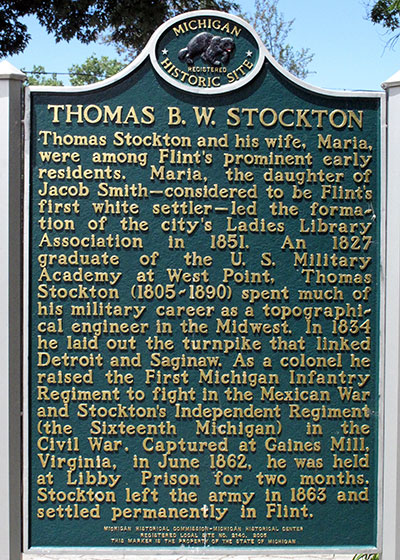
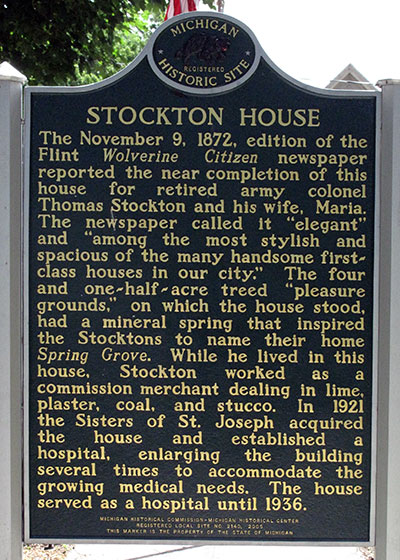
Marker Text: Thomas Stockton and his wife, Maria, were among Flint's prominent early residents. Maria, the daughter of Jacob Smith ~ considered to be Flint's first white settler ~ led the formation of the city's Ladies Library Association in 1851. An 1827 graduate of the U.S. Military Academy at West Point, Thomas Stockton (1805 - 1890) spent much of his military career as a topographical engineer in the Midwest. In 1834 he laid out the turnpike that connected Detroit and Saginaw. As a colonel he raised the First Michigan Infantry Regiment to fight in the Mexican War and Stockton's Independent Regiment (the Sixteenth Michigan) in the Civil War. Captured at Gaines Mill, Virginia, in June 1862, he was held at Libby Prison for two months. Stockton left the army in 1863 and settled permanently in Flint.
This marker is located at 720 Ann Arbor St, Flint MI. It was erected in 2005.
The marker is very easy to get to and see in front of the buildling. Currently the building is used as office space by mulitple businesses and is does not seem open to the public.
Resisting Slavery
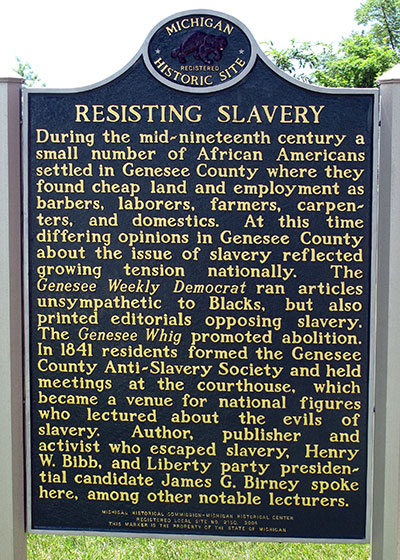
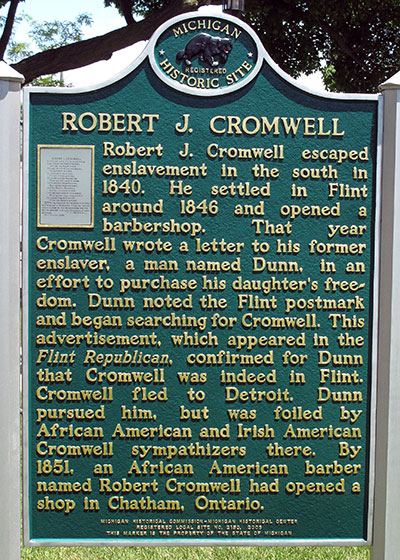
This marker is located in the Genesee County Courthouse Grounds at 900 S. Saginaw Street in Flint, MI. It was erected in 2005.
It is easily accessable and in a public place to be viewed.
Sarah Emma Edmonds
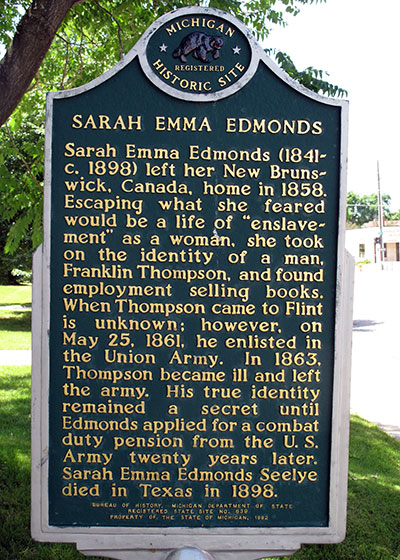
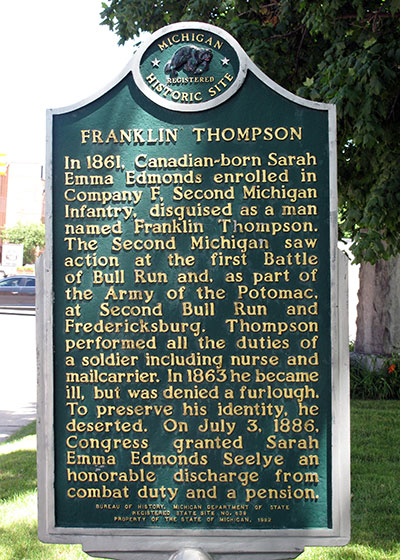
This marker is located in the Genesee County Courthouse Grounds at 900 S. Saginaw Street in Flint, MI. It was erected in 1992.
It is easily accessable and in a public place to be viewed.
Byron, Michigan
Byron Cemetery
Marker Text: Byron Cemetery originated with the 1837 interment of Theodore H. Provost, the son of one of Byron's founders. According to local historians, Chippewa lived on this site until it became a cemetery. Byron Cemetery contains some sixteen hundred graves. The remains of fifty-six Civil War soldiers and veterans are interred here, including those of James Sleeth, a surgeon during the war who later became a lawyer and newspaper publisher. A large pedestal with crossed rifles honors unknown Civil War dead.
This marker is located near the intersection of Hamilton and Water St, Byron MI. It was erected in 1998.
Adrian, Michigan
Camp Williams/4th Michigan Volunteer Infantry
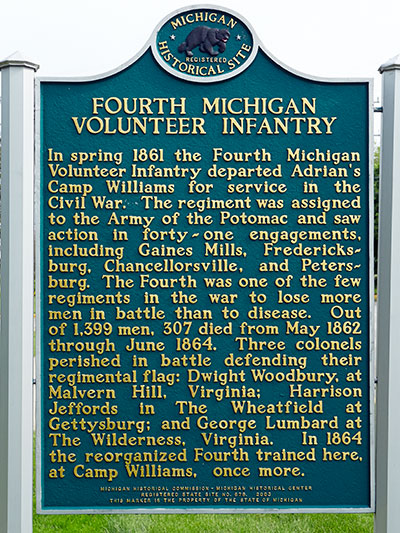
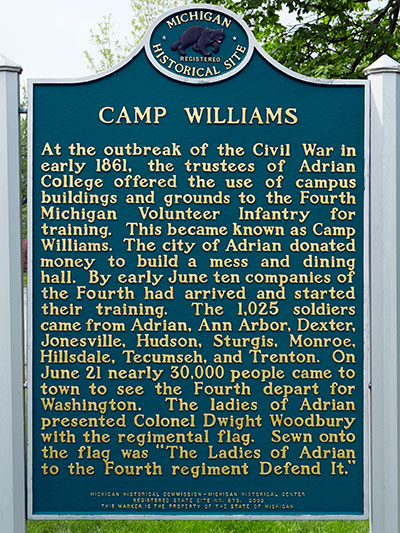
Marker Text: At the outbreak of the Civil War in early 1861, the trustees of Adrian College offered the use of campus buildings and grounds to the Fourth Michigan Volunteer Infantry for training. This became known as Camp Williams. The city of Adrian donated money to build a mess and dining hall. By early June ten companies of the Fourth had arrived and started their training. 1,025 soldiers came from Adrian, Ann Arbor, Dexter, Jonesville, Hudson, Sturgis, Monroe, Hillsdale, Tecumseh, and Trenton. On June 21 nearly 30,000 people came to town to see the Fourth depart for Washington. The ladies of Adrian presented Colonel Dwight Woodbury with the regimental flag. Sewn into the flag was "The Ladies of Adrian to the Fourth regiment Defend It." In spring 1861 the Fourth Michigan Volunteer Infantry departed Adrians' Camp Williams for service in the Civil War. The regiment was assigned to the Army of the Potomac and saw action in forty~one engagements, including Gaines Mills, Fredericksburg, Chancellorsville, and Petersburg. The Fourth was one of the few regiments to lose more men in battle than from disease. Out of 1,399 men, 307 died from May 1862 through June 1864. Three colonels died in battle defending their regimental flag: Dwight Woodbury, at Malvern Hill, Virginia; Harrison Jeffords in The Wheatfield at Gettysburg; and George Lumbard at The Wilderness, Virginia. In 1864 the reorganized Fourth trained here, at Camp Williams, once more.
This marker is located on North Hall at Adrian College, Adrian MI. It was erected in 2003.
Oakwood Cemetery
Marker Text: With its parklike setting, wooded pathways and variety of monuments, Oakwood Cemetery is an outstanding Victorian Era cemetery. Local citizens, including Adrian founder Addison, Comstock, created Oakwood Cemetery in 1848. Originally 22 acres, by 1968 the cemetery had grown to 120 acres. Many of Adrian's earliest settlers are buried here. The first internment was six year-old Oscar Augustus Stevens. Rachel Sightler, a former slave, and Martin Loop, a Civil War veteran who died at age 103, are buried here. In addition, the cemetery contains the remains of prominent Michiganians including Governor William L. Greenly (1813-1883), Governor Charles M. Croswell (1825 - 1886), and Michigan Supreme Court Justice Thomas M. Cooley (1824 - 1898).
This marker is located at 101 Oakwood St, Adrian MI. It was erected in 2001.
Marshall, Michigan
GAR Hall
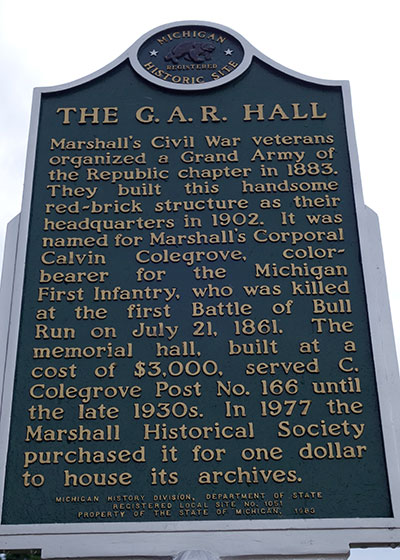
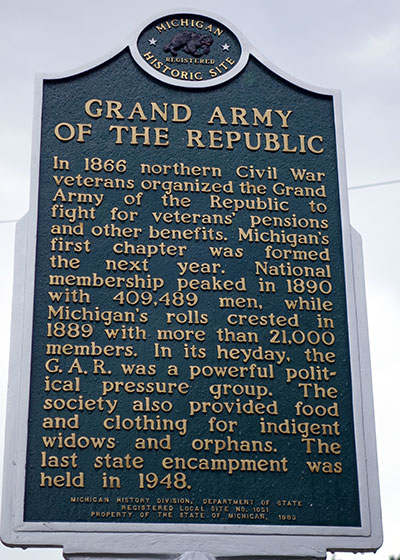
Marker Text: Marshall's Civil War veterans organized a Grand Army of the Republic chapter in 1883. They built this handsome red-brick structure as their headquarters in 1902. It was named for Marshall's Corporal Calvin Colegrove, colorbearer for the Michigan First Infantry, who was killed at the first Battle of Bull Run on July 21, 1861. The memorial hall, built at a cost of $3,000, served C. Colegrove Post No. 166 until the late 1930s. In 1977 the Marshall Historical Society purchased it for one dollar to house its archives.
This marker is located on East Michigan at Exchange in Marshall. It was erected in 1983.
Lt. George A. Woodruff
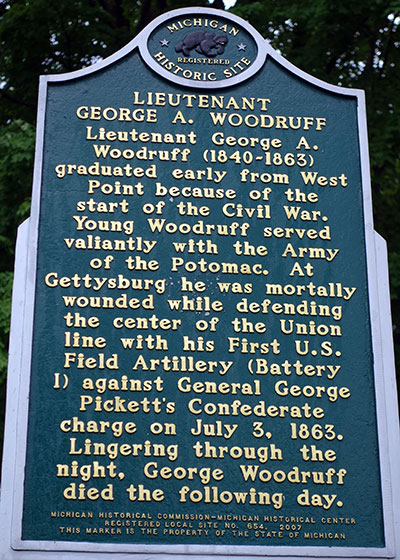
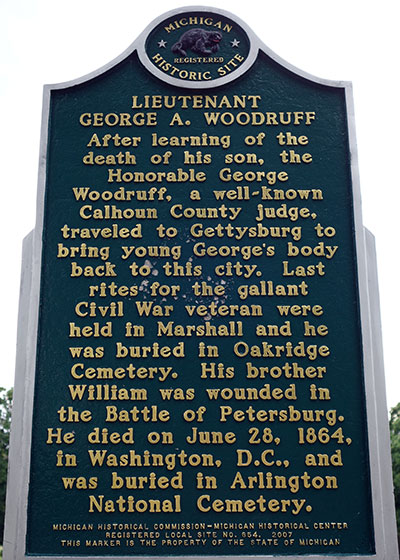
Marker Text: Lieutenant George A. Woodruff (1840 - 1863) graduated from West Point in only three years because of the start of the Civil War. Young Woodruff served valiantly in the battles of the Army of the Potomac. At Gettysburg he was mortally wounded while defending the center of the Union line with his 1st United States Field Artillery (Battery I) against General George Pickett's charge on July 3, 1863. Lingering through the night, George A. Woodruff died the following day. After learning of the death of his son, the Honorable George Woodruff, a well-known Calhoun County judge, traveled to Gettysburg to bring young George's body back to this city. Last rites for the gallant Civil War veteran were held in Marshall and he was buried here in Oakridge Cemetery. His brother William was killed in the Battle of Petersburg and subsequently buried in the Gettysburg National Cemetery, in Gettysburg, Pennsylvania.
This marker is located at 614 Dibble Street in Marshall. It was erected in 1979.
Coldwater, Michigan
Branch County
Marker Text: Branch County, named for John Branch, President Andrew Jackson's secretary of the navy, was one of thirteen counties established by the territorial legislature in 1829. The village of Branch, located three miles southwest of Coldwater was the original county seat, but in 1842 county commissioners decreed that the seat be moved to Coldwater. In 1848 a courthouse was erected on this site. The Chicago Road (now US-12) and the coming of the Michigan Southern Railroad in 1850 attracted settlers. During the 1850s and 1860s, Coldwater was a horse training and breeding center. Local breeders provided three thousand horses to the Union Army during the Civil War. In the 1870s and 1880s, the manufacture of cigars contributed to Coldwater's prosperity. In 1882, some 13.4 million cigars were manufactured in Coldwater.
This marker is located at 31 Division St, Coldwater MI. It was erected in 1992.
Wing House Museum
Marker Text: This impressive Second Empire style home with mansard roof was constructed in 1875 for Jay Chandler (1850-1884) and his young bride Frances. On this site from 1847-1871 had stood the Parrish flouring mill. Jay, the fourth son of locally prominent Albert Chandler, followed his brothers into the family hardware business. Albert founded the Coldwater Sentinel and served as the city's first mayor. Jay Chandler sold his home to Lucius Wing in 1882. Lucius M.Wing (1839-1921), Civil War captain, county sheriff, and prominent businessman, purchased this residence in 1882. That same year he served a term as mayor. Making notable contributions to the industrial, financial and social life if the city, he was the long time president of the local bank, a manufacturer of cigars and the founder of the Bon Ami Social club. The house remained in the family for three generations until acquired by the Branch County Historical Society in 1974 for use as a historical museum.
This marker is located at 27 S. Jefferson, Coldwater MI. It was erected in 1979.
Vandalia, Michigan
The Underground Railroad
Marker Text: Vandalia, prior to the Civil War, was the junction of two important "lines" of the "Underground Railroad." Slaves fleeing through Indiana and Illinois came to Cass County, where Quakers and others gave them shelter. Fugitives seeking a refuge in Canada were guided to "stations" to the east. Many stayed here and built a unique Neqro rural colony. Slave-hunting by Kentuckians led to legal action and increased North-South tensions.
This marker is located at Bonnie Elk Park on M-60, Vandalia MI. It was erected in 1957.
Grand Rapids/Holland area
Veteran's Cemetery
Marker Text: In April 1886, the Board of Managers of the Michigan Veterans' Facility set aside five acres for a cemetery. The Grand Rapids Post of the Grand Army of the Republic dedicated the cemetery on Memorial Day, May 31, 1886. The original cemetery was designed in the form of a Maltese cross with 262 grave sites in each of its four sections. In 1894 a granite statue of a Civil War soldier was placed at the center of the cross. By the time of its centennial in 1986, the cemetery had recorded over 4,000 burials of veterans and their dependents.
This marker is located at 3000 Monroe Ave NW, Grand Rapids MI. It was erected in 1986.
Veteran's Home
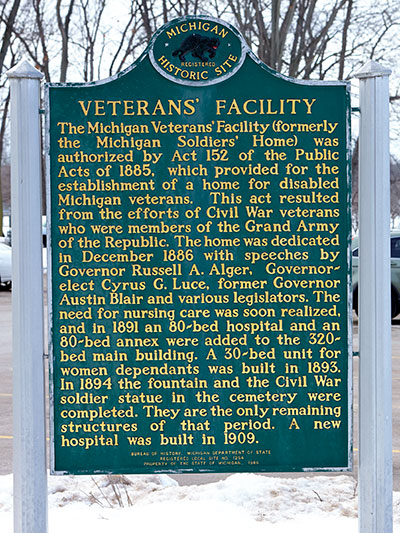
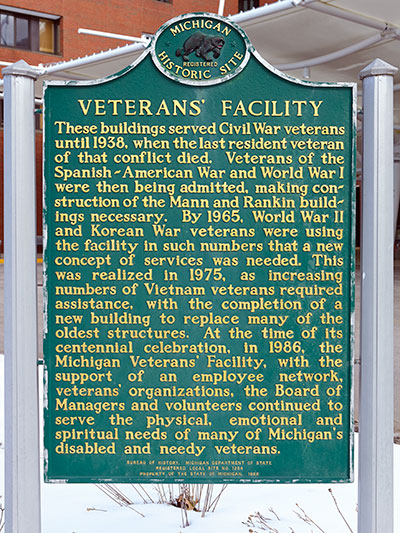
This marker is located at the Grand Rapids Home for Veterans. The address is 3000 Monroe Ave. NE, Grand Rapids, MI.
Van Raalte Farm
Marker Text: In 1847 Holland's founder, the Reverend Albertus C. Van Raalte, purchased this property from the federal government for $2.32 an acre. When his son Benjamin returned from the Civil War in 1865, Van Raalte gave him the 160-acre tract. By 1873, when Benjamin married Julia Gilmore, he had built this Classical Revival-inspired house and two barns. Benjamin was a prosperous farmer and agricultural implements dealer. When he died in 1917, his daughter Julia Christina and husband Orlando C. Relmold, inherited the property. The Relmold family came to the farm each summer. Julia Christina considered it her home and often came here for extended visits. In 1883, Benjamin's Great grandchildren sold the farm to the city of Holland which preserved it as a park. The Van Raalte Farm is listed in the National Register of Historic Places.
This marker is located at 1076 E 16th St, Holland MI. It was erected in 1995.
126th Infantry
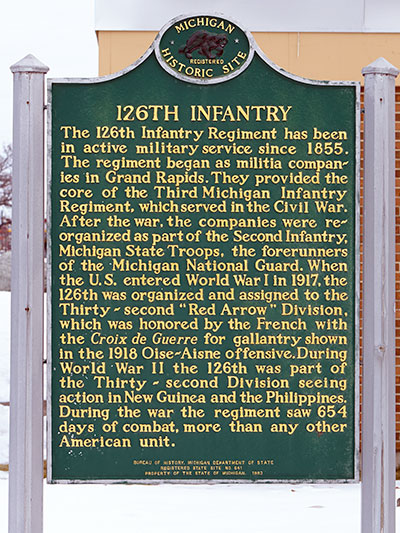
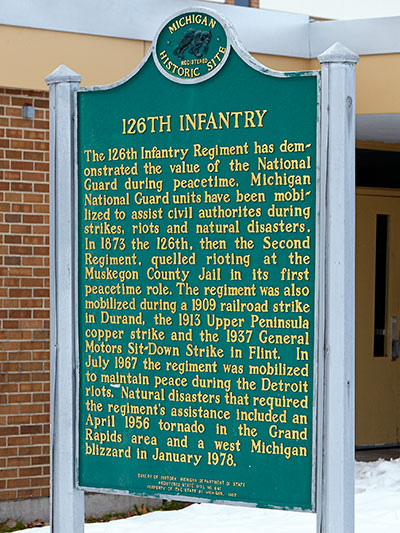
Marker Text: The 126th Infantry Regiment has been in active military service since 1855. The regiment began as militia companies in Grand Rapids. They provided the core of the Third Michigan Infantry Regiment, which served in the Civil War. After the war, the companies were reorganized as part of the Second Infantry, Michigan State Troops, the forerunner of the Michigan National Guard. When the U.S. entered World War I in 1917, the 126th was organized and assigned to the Thirty-second "Red Arrow" Division, which was honored by the French with the Croix de Guerre for gallantry shown in the 1918 Oise-Aisne offensive. During World War II the 126th was part of the Thirty-second Division seeing action in New Guinea and the Philippines. During the war the regiment saw 654 days of combat, more than any other American unit.
This marker is located at 1200 44th St SW, Wyoming MI. It was erected in 1992.
William Hyser
Marker Text: William Hyser (1826 - 1909), pioneer surgeon and Civil War captain, came to Plainfield Township in 1850, when it was a lumber center. In 1852 he built this Greek Revival house as a home and an office for his medical and civic duties. He was at various times township clerk, school inspector and supervisor, and justice of the peace. The house has also served as a stagecoach station and a post office. In 1976 it was moved to its present site. The only remaining structure from the original Plainfield village, it is now restored as a museum.
This marker is located at 6440 West River Rd, Plainfield MI. It was erected in 1981.
Benzonia, Michigan
Bruce Catton
Marker Text: Historian, author, editor, Bruce Catton (1899-1978) is best known for his two Civil War trilogies -- The Army of the Potomac and The Centennial History of the Civil War. Born in Petoskey, Catton spent most of his childhood in Benzonia, where his father accepted a teaching position at Benzonia Academy. In 1906 he became the academy's principal. The Catton's lived in this building, which was the principal's home and the girl's dormitory. Catton served in the navy and worked for newspapers and the federal government when at the age of fifty-one, he published his first Civil War Book, Mr. Lincoln's Army. In 1954 he became the editor of American of American Heritage magazine and was awarded the Pulitzer Prize for A Stillness at Appomattox. He died at his Frankfort, Michigan, summer home in 1978. Bruce Catton's fascination with the Civil War began in Benzonia, where he grew up with Civil War veterans, who "gave a color and a tone, not merely to our village life, but to the concept of life with which we grew up." He was impressed by their certainty, their values and their faith in bravery, patriotism, freedom and the progress of the human race. He wrote, "I think I was always subconsciously driven by an attempt to restate that faith and to show where it was properly grounded, how it grew out of what a great many young men on both sides felt and believed and were brave enough to do." In the 1970s, Catton turned his thoughts to his native state, writing Waiting for the Morning Train, an account of the Michigan of his boyhood, and Michigan: A Bicentennial History.
This marker is located at 891 Michigan Ave, Benzonia MI. It was erected in 1984.
Lincoln, Michigan
West Harrisville Depot
Marker Text: In 1893 lumberman and Civil War hero Russell Alger led the consolidation of several lumber railroads as the Detroit, Bay City, and Alpena Railroad, bringing passenger and freight service to this region for the first time. Built in 1886, the depot was taken over by the Detroit and Mackinac Railroad in 1895 and renovated in 1913. Service ceased in 1927 and from 1930 to 1996 the building served as a residence. Citizens saved the depot from demolition in 1997.
This marker is located at 116 Fiske St, Lincoln MI. It was erected in 2001.
Roscommon, Michigan
Terney House
Marker Text: William J. Terney, lumber baron and Civil War veteran, moved to the Roscommon area in 1887 and erected this house in the late 1880s. Shortly afterwards, he began extensive lumbering here and was instrumental in bringing the railroad through the village. Near the turn of the century, Terney was appointed county treasurer. He was elected village president in 1904, and in later years served as an officer for the Michigan State Fair. Terney engaged in a real estate business until his death in 1926. Local banker William B. Orcutt purchased this large Queen Anne residence from Terney in 1910. Its interior features white oak parquet flooring and ornate paneling, linking it to the once booming lumbering epoch of Roscommon.
This marker is located at 603 Lake St, Roscommon MI. It was erected in 1978.
Saugatuck, Michigan
First Congregational Church
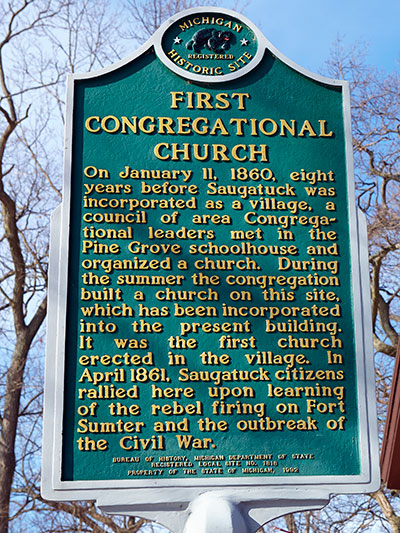
Marker Text: On January 11, 1860, eight years before Saugatuck was incorporated as a village, a council of area Congregational leaders met in the Pine Grove schoolhouse and organized a church. During the summer the congregation built a church on this site, which has been incorporated into the present building. It was the first church erected in the village. In 1861, Saugatuck citizens rallied here upon learning of the rebel firing on Fort Sumter and the outbreak of the Civil War.
This marker is located at 296 Hoffman, Saugatuck MI. It was erected in 1992.
Fox's Gap - South Mountain Battlefield, Maryland
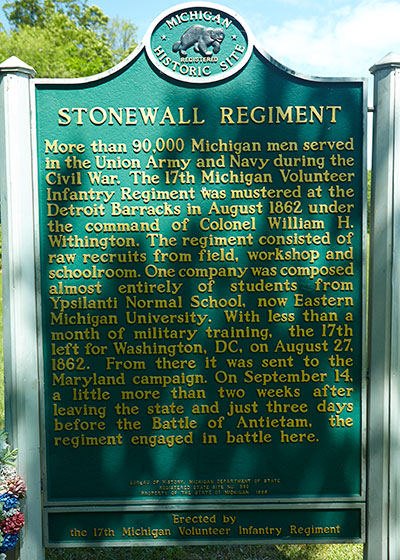
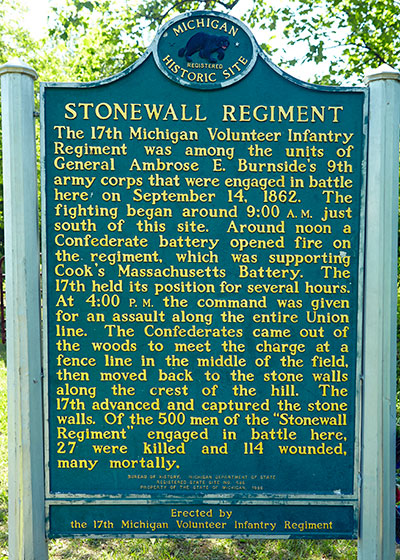
Additional background: More than ninety thousand Michigan men served in the Union Army and Navy during the Civil War. The 17th Michigan Volunteer Infantry Regiment was mustered at the Detroit Barracks in August 1862 under the command of Colonel William H. Withington. The regiment consisted of raw recruits from field, workshop and schoolroom. One company was composed almost entirely of students from Ypsilanti Normal School, now Eastern Michigan University. With less than a month of military training, the 17th left for Washington DC, on August 27, 1862. From there it was sent to the Maryland campaign. On September 14, a little more than two weeks after leaving the state and just three days before the Battle of Antietam, the regiment engaged in battle here. The 17th Michigan Volunteer Infantry Regiment was among the units of General Ambrose E. Burnside's 9th army corps that were engaged on battle here on September 14th 1862. The fighting began around 9:00 A.M. just south of this site. Around noon a Confederate battery opened fire on the regiment, which was supporting Cook's Massachusetts Battery. The 17th held its position for several hours. At 4:00 P.M. the command was given for an assault along the entire Union line. The Confederates came out of the woods to meet the charge at a fence line in the middle of the field, then moved back to the stone walls along the crest of the hill. The 17th advanced and captured the stone walls. Of the 500 men of the "Stonewall Regiment" engaged in battle here, 27 were killed and 114 wounded, many mortally.
This marker is located at 8629 Reno Monument Rd, Middleton MD. It was erected in 1986.
Waynesboro, Pennslyvania
Michigan Cavalry Brigade
Marker Text: The Michigan Cavalry Brigade was formed in December 1862 of the 5th, 6th and 7th Michigan Cavalry regiments with General Joseph T. Copeland Commanding. In June 1863 the addition of the 1st Michigan Cavalry and Battery M, 2nd U.S. Artillery, completed the Brigade. On the eve of the Battle of Gettysburg, George A. Custer of Monroe assumed command with his promotion to brigadier general. On July 3, 1863, the brigade helped repulse General J.E.B. Stuarts Confederate cavalry. It fought in every major campaign of the Army of the Potomac until the surrender of General Lee at Appomattox Court House in April 1865. Nine brigade members received Medals of Honor for heroism during the Civil War.
This marker is located at 14325 Buchanan Trail E, Waynesboro PA. It was erected in 2012.
Richmond, Kentucky
Michigan Light Artillery Regiment
Marker Text: During the Civil War more than three thousand men served in Michigan's twelve artillery batteries. The regiment saw action in both major theaters. Unlike infantry regiments, six-gun artillery batteries served as detached units. Light artillery was mobile. Six-horse limbers pulled an ammunition caisson and a gun that delivered devastating fire using solid shot, explosive shell, case or canister. Michigan's first unit, the Coldwater Light Artillery Battery, mustered in on May 28, 1861; its last battery formed up in 1864. In late August 1862, and the six-gun battery F and a two-gun section of battery G, under Lieutenants Lanphere, Hale, Paddock and Brown fought against superior numbers in their first battle here at Richmond. Batteries F and G of Michigan's First Light Artillery went into action here on August 29, 1862. They were the only Union artillery on the field of battle. Despite inadequate training and ammunition, they provided accurate fire that helped drive back the confederates "with admirable effect." Early on August 30 the batteries defended the initial Union battle line. During successive Union withdrawals, the guns served as rallying points or as the rear guard. Seven of the eight were brought off the field in the last Federal withdrawal. In the final chaotic retreat, lacking infantry support and ammunition, the seven fell into enemy hands. Reported losses were 7 killed, 12 wounded and 65 captured. The two batteries later fought during the Vicksburg and Atlanta campaigns and at the battle of Nashville.
This marker is located at 830 Battlefield Memorial Hwy, Richmond KY. It was erected in 2012.
Perryville, Kentucky
Michigan at Perryville
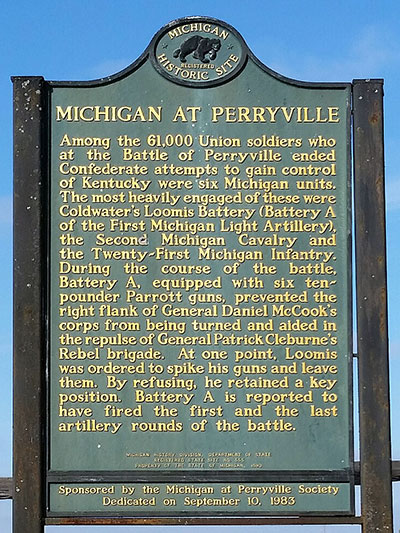
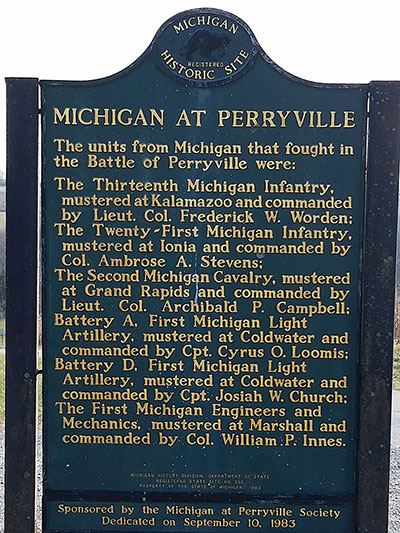
Marker Text: Among the 61,000 Union soldiers who at the Battle of Perryville ended Confederate attempts to gain control of Kentucky were six Michigan uits. The most heavily engaged of these were Coldwater's Loomis Battery (Battery A of the First Michigan Light Artillery), the Second Michigan Cavalry and the Twenty-First Michigan Infantry. During the course of the battle, Battery A, epuipeed with six ten-pounder Parrott guns, prevent the right flank of General Daniel McCook's corps from being turne and aided in the repulse of General Patrick Cleburne's Rebel brigade. At one point, Looms was ordered to spike his guns and leave them. By refusing, he retained a key position. Battery A is reported to have fired the first and the last artillery rounds of the battle
The units from Michigan that fought in the Batle of Perryville were:
The Thirteenth Michgan Infantry, mustered at Kalamzaoo and commanded by Lieut. Col Frederick W. Worden;
The Twenty-First Michigan Infantry, mustered at Ionia and commanded by Col. Ambose A. Stevens;
The Second Michigan Cavalry, mustered at Grand Rapids and commanded by Lieut Col. Archibald P. Campbell;
Battery A, First Michigan Light Artillery, mustered at Coldwater and commanded by Cpt. Cyrus O. Loomis;
Battery D, First Michigan Light Artillery, mustered at Coldwater and commanded by Cpt. Josiah W. Church;
The First Michigan Engineers and Mechanics, mustered at Marshall and commanded by Col. William P. Innes.
The marker is located on the Squire Bottoms Farm along the current day Hayes-May Rd. on the Perryville Battlefield.
Thanks to Micah Trent for help securing these images.
